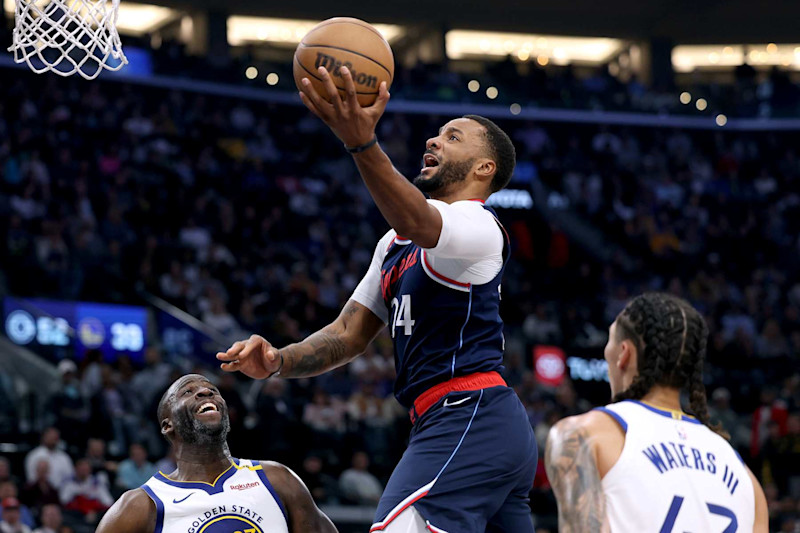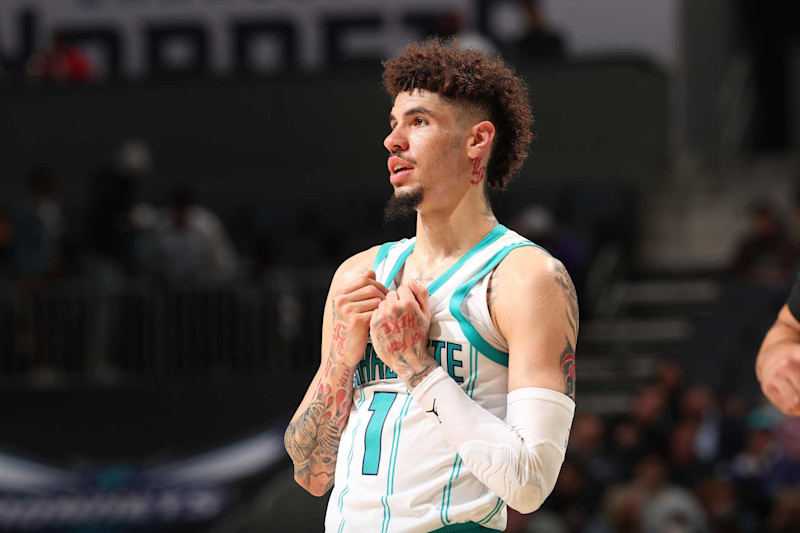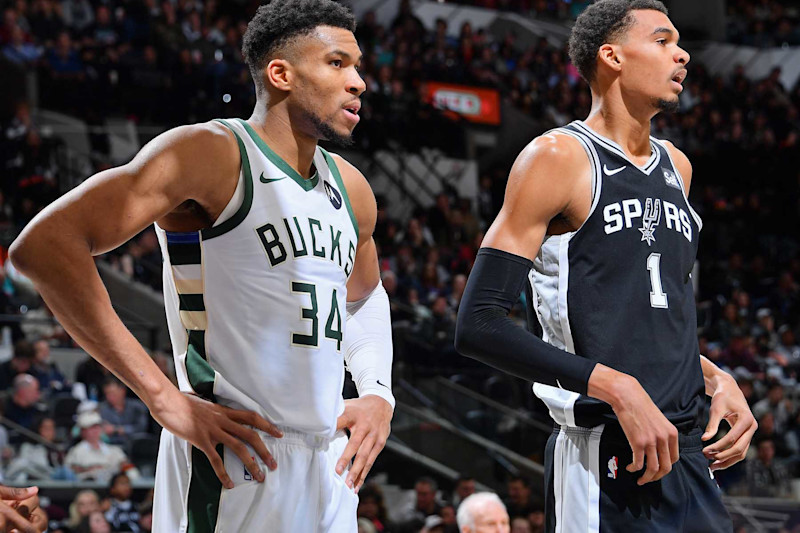
Logan Riely/NBAE via Getty Images
The NBA trade market is creeping closer to its unofficial opening.
We’re here to hypothetically speed things up.
Teams might take a little more time to really start talking trades—the pool of trade-eligible players will exponentially increase in mid-December—but we don’t have to (and don’t want to) wait that long. Not when we have trade machines at the ready to cook up a batch of blockbuster ideas capable of creating new championship contenders.
Golden State Finds a Second Scorer

Harry How/Getty Images
Golden State Warriors receive: Norman Powell
Los Angeles Clippers receive: De’Anthony Melton and Jonathan Kuminga
The Warriors have a championship-level defense and a Stephen Curry-led offense. That combination has been known to spark a few title runs before.
What the Dubs don’t have, though, is a clear second option on offense, and that feels like a potentially fatal flaw given how much must go right to orchestrate a Finals run. That’s why Golden State has made multiple attempts to find Curry a true co-star, but there are reasons those searches keep coming up empty. The Warriors don’t have the deepest asset collection, and under the collective bargaining agreement, it’s tricky for them to make the finances work on a major move.
That’s why they could consider buying high on Powell. Is it fair to be skeptical about a 31-year-old playing at a higher level than ever before? Absolutely. But if this late-career breakout is remotely sustainable, then that’s plenty of production added without breaking the bank.
Even if Powell proves to be less of a true second option and more like someone who can share that role with the resurgent Andrew Wiggins, that could work. The formula wouldn’t be that much different than that of the Dubs’ last title team in 2021-22. Powell’s numbers now look better than Klay Thompson’s were then, and if Buddy Hield can fill the instant-offense role that Jordan Poole did then, the Dubs would be in business.
Warriors fans might quibble that this equates to selling low on Kuminga, but given his inconsistent role and impending (restricted) free agency, it’s possible (or, debatably, probable) his trade value won’t rise between now and the trade deadline.
And considering Melton is shelved for this season (torn ACL) and unsigned beyond it, then it’s just salary-filler and Kuminga in exchange for ample scoring support. That feels fair, provided you buy the notion that at least some of Powell’s emergence is for real.
The harder sell here might be convincing the Clippers to abandon whatever win-now hopes they’re holding, but between Kawhi Leonard’s latest ongoing absence and the club’s middling efficiency, one could argue it’s in the franchise’s best interest to prioritize the future over the present.
If the Clippers share that view, then selling high on Powell makes plenty of sense. So, too, would buying low on Kuminga, the seventh overall pick of the 2021 draft who’s shown flashes of high-end shot-creation and looks the part of a versatile, athletic defensive stopper.
Zion Williamson Gets the Hornets Buzzing

Jared C. Tilton/Getty Images
Charlotte Hornets receive: Zion Williamson
New Orleans Pelicans receive: Tidjane Salaün, Grant Williams, Cody Martin, Vasilije Micić, a 2027 first-round pick (top-two protected, via DAL), a 2027 first-round pick (lottery-protected, via MIA) and a 2025 second-round pick (their own)
The Pelicans clearly carried high hopes into this season. If they didn’t, they never would’ve sacrificed Dyson Daniels and a pair of first-round picks to get Dejounte Murray this summer.
When Murray suffered a fractured hand on opening night, though, it was an ominous sign that this might be a snake-bitten season for New Orleans. With the Pelicans buried in the Western Conference standings and saddled by an injury report that has, at times, reached the length of a short story, maybe a franchise reset is in order.
While Williamson’s trade value admittedly isn’t the highest it’s ever been, maybe it’s still high enough for the Pelicans to wash their hands of the former top pick and stop hoping this will be the year in which he finally stays healthy.
They’d get a decent haul here in return—especially if they can clip one or more of the incoming vets for additional assets—plus they could fully commit to a tanking effort that may hold a jackpot prize depending on how the 2025 lottery plays out.
The Hornets, meanwhile, would add an impact player in Williamson to pair with LaMelo Ball and Brandon Miller, a core that—if everyone stays healthy—could pave a path to championship contention in the relatively near future. The switch may not flip this season, but that’s fine when Williamson, who turned 24 in July, would be the senior member of the trio.
While Charlotte fans might be scared off by the collective injury risk of a Ball-Williamson duo, it’s tough to deny the sky-high offensive ceiling it would possess. And if Miller settles in as an all-purpose defensive stopper and high-end third option, that’s a group that could get awfully competitive with the right pieces around it.
If the Hornets plan to keep building with Ball—the alternative is an option we’ll explore later—they need to find him a legitimate co-star. A healthy Williamson clearly qualifies as such, and while the red flags attached to him are legitimate concerns, they also keep his trade cost at a relatively reasonable rate.
Magic Move All-In with LaMelo Ball

Kent Smith/NBAE via Getty Images
Orlando Magic receive: LaMelo Ball
Charlotte Hornets receive: Cole Anthony, Anthony Black, Jett Howard, Tristan da Silva, 2027 first-round pick, 2029 first-round pick and first-round pick swaps in 2028 and 2030
Armed with an elite, chaos-creating defense and one of basketball’s best forward tandems in Paolo Banchero and Franz Wagner, the Magic are so close to the championship chase they can almost touch it. If they actually want to join it, though, they might need a high-end perimeter shot-creator to take them over the top.
LaMelo Ball fits that description about as well as anyone who could be reasonably connected to the trade market. And while certain members of the Hornets’ faithful might scoff at that characterization, this is Ball’s fifth season in Buzz City, and Charlotte feels no closer to contending than it did when he arrived as the No. 3 pick of the 2020 draft.
In fact, considering the Hornets were play-in tournament participants during Ball’s first two seasons, you could argue the organization has moved in the opposite direction.
It feels like there’s a chance, then, that Ball shakes loose at some point—either by his own doing or the organization’s desire to start over and try building around Brandon Miller. Should Ball happen to even approach the rumor mill, the Magic should be all over him.
Might it take a little time to sort out the offensive hierarchy between Ball, Banchero and Wagner? Perhaps, but maybe Ball would be content with perking up his playmaking with scoring threats of this magnitude around him, and while Wagner has shined in Banchero’s absence, Wagner might still be most comfortable playing Robin to someone else’s Batman (or a couple of Batmen, in this case).
“He is a young man that wants to do all of the right things—by the game of basketball, by his work ethic, by his professionalism, by the teammate that he is,” Magic coach Jamahl Mosley said of Wagner recently. “So sometimes, taking tough shots is not always a thing he wants to do. He just wants to make the right play.”
What’s perhaps most impressive about Orlando is the fact it’s deep enough—in players and trade assets—to make this kind of trade without becoming too top-heavy. The Magic would emerge from this trade with one of the league’s best young trios, but also still a strong support staff and a few more movable parts to throw in future trades if needed. That sounds like a championship recipe, assuming everyone stays healthy, obviously.
Speaking of staying healthy, that’s been a challenge for Ball, which could give the Hornets some hesitation about trying to keep building around him. If they see superstar potential in Miller, they would at least be intrigued by the idea of making him their centerpiece and using this package to flesh out the roster around him.
Black, Howard and da Silva were all top-20 picks from the past two drafts, and Anthony, the 15th pick in 2020, is still shy of his 25th birthday. All four are potential long-term keepers, and then the two firsts and two first-round swaps can help deliver more building blocks down the line.
Spurs Supercharge Their Ascension With Giannis-Wemby Frontcourt

Photos by Michael Gonzales/NBAE via Getty Images
San Antonio Spurs receive: Giannis Antetokounmpo
Milwaukee Bucks receive: Jeremy Sochan, Keldon Johnson, Malaki Branham, Zach Collins, a 2025 first-round pick (top-10 protected, via CHI), a 2027 first-round pick (via ATL), a 2030 first-round pick (via DAL), a 2031 first-round pick (via MIN) and a 2026 first-round pick swap (via ATL)
While the Bucks have course-corrected a bit from their disastrous start to the season, they still don’t appear anywhere close to contention. The best hopes they have are all tied to the fact they have Antetokounmpo on the roster, but that can’t be the best selling point for the two-time MVP himself.
It might be tough to tell exactly how he feels about his supporting cast, but it’s hard to see how he has any faith in its long-term outlook. Khris Middleton can’t get healthy, Damian Lillard can’t find his Portland form, Milwaukee maybe can’t afford Brook Lopez after this season and the young players can’t crack coach Doc Rivers’ rotation.
Things look bleak for the Bucks, which has the hoops world wondering aloud how much longer Antetokounmpo sticks it out. As Western Conference team executive told CBS Sports’ Bill Reiter earlier this season, “teams are circling—and hopeful” that Antetokounmpo might want out sooner than later.
If Milwaukee is forced to trade Antetokounmpo, it will surely demand a mountain of trade assets, which considerably thins his list of realistic landing spots. Teams not named the Spurs, Thunder or Jazz would have trouble cobbling together enough picks to catch the Bucks’ attention. Since Oklahoma City is a contender already, there isn’t a point of putting it into this exercise. Utah, on the other hand, looks so far away from contending that even an Antetokounmpo trade wouldn’t have the Jazz competing at that level.
The Spurs, meanwhile, have simultaneously stockpiled assets while fueling the growth of budding superstar Victor Wembanyama. They still aren’t ready to be considered even shadow contenders, but add a megastar of Antetokounmpo’s ilk to the mix, and they might surge all the way to heavyweight-contender status.
A Wembanyama-Antetokounmpo pairing feels capable of almost everything—or actually everything if Wembanyama finds more consistency with his outside shot. Both are intimidating rim protectors who can comfortably (and capably) defend away from the basket. Offensively, either is a threat to pop for 50 points, both are unguardable around (and above) the rim and each offers enough creativity to generate shots for himself and his teammates.
San Antonio would lose some depth in this deal, but not deplete the roster. Keeping both Devin Vassell and Stephon Castle would be a massive win (and worth adding more outgoing firsts if needed), as both should be capable of filling critical support roles sooner than later. Plus, the Spurs would still have Chris Paul and Tre Jones to help organize the offense. There’s a non-zero chance they could be ready to contend yet this season.
The Bucks, meanwhile, would be looking for a rebuilding kit in any Antetokounmpo trade. This offers plenty of avenues to potential centerpieces. The free future firsts are all unprotected, as is the first-round swap. The protection on Chicago’s pick dips to top-eight if it doesn’t move this year. While Collins would be nothing more than a money-matcher, all three of Sochan, Johnson and Branham could factor into the franchise’s long-term plans.
Leave a Reply